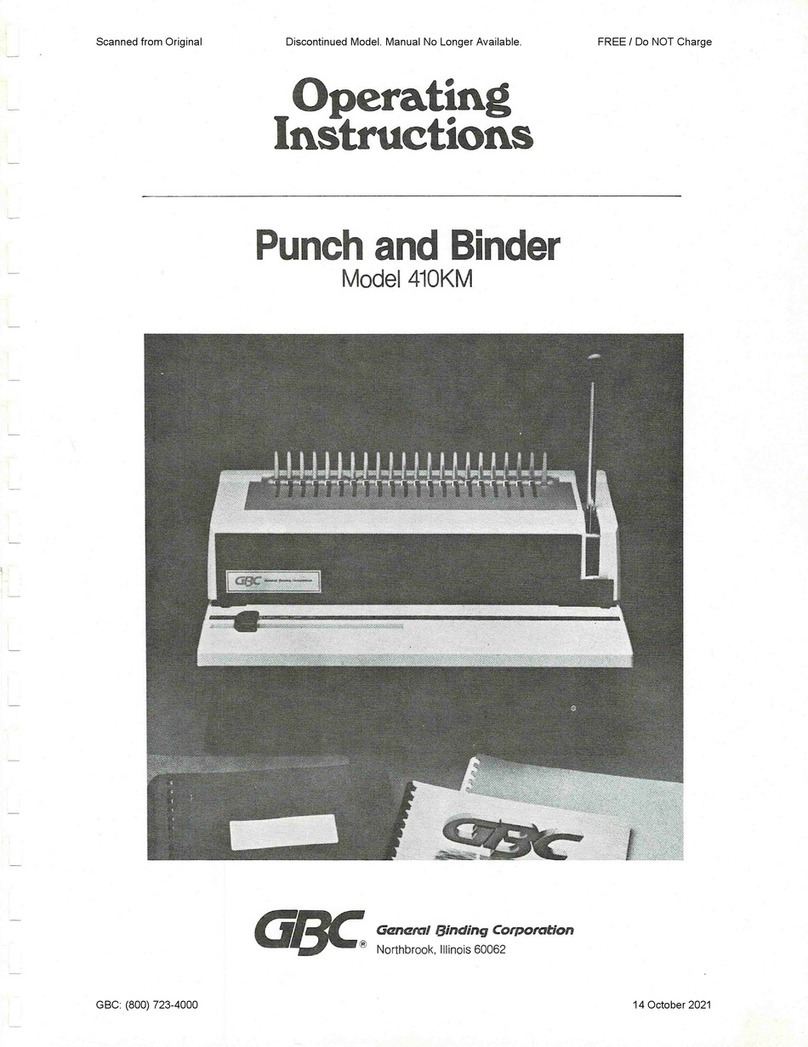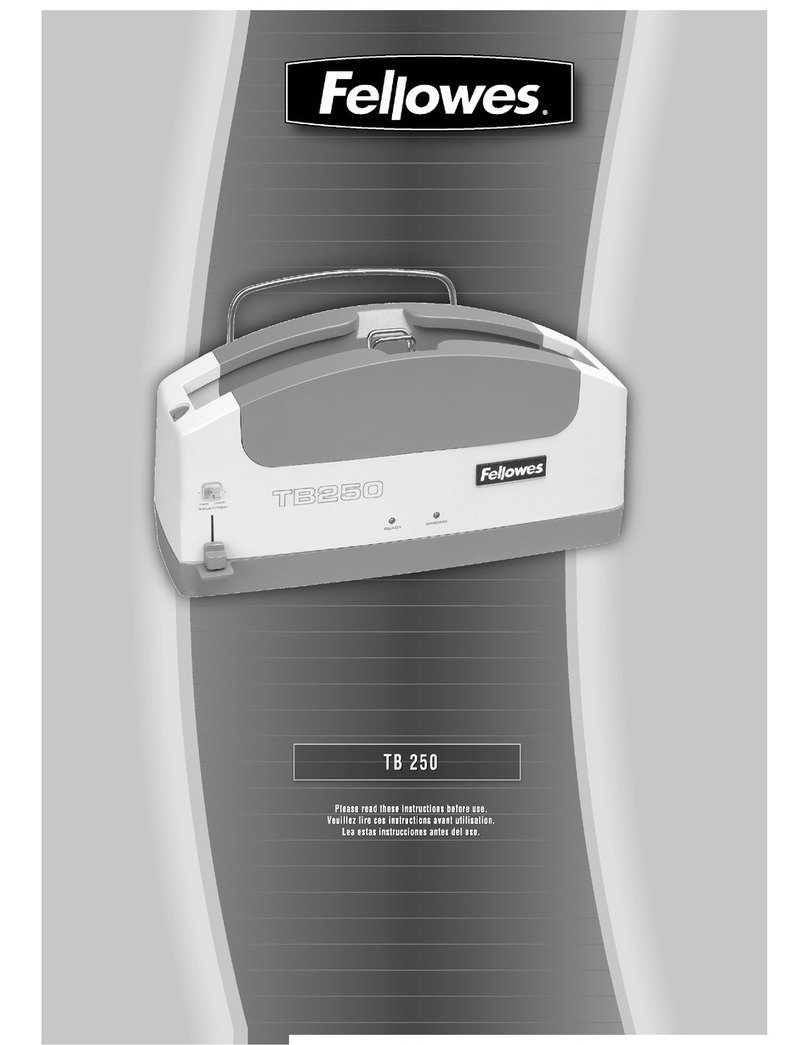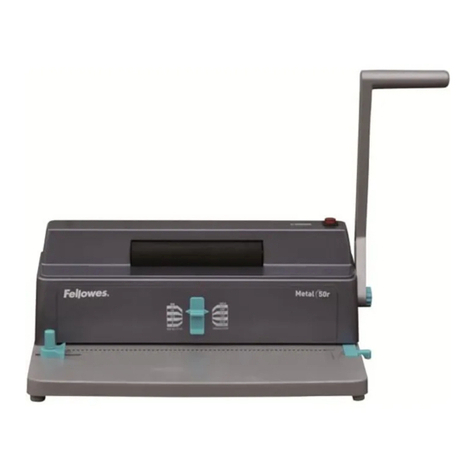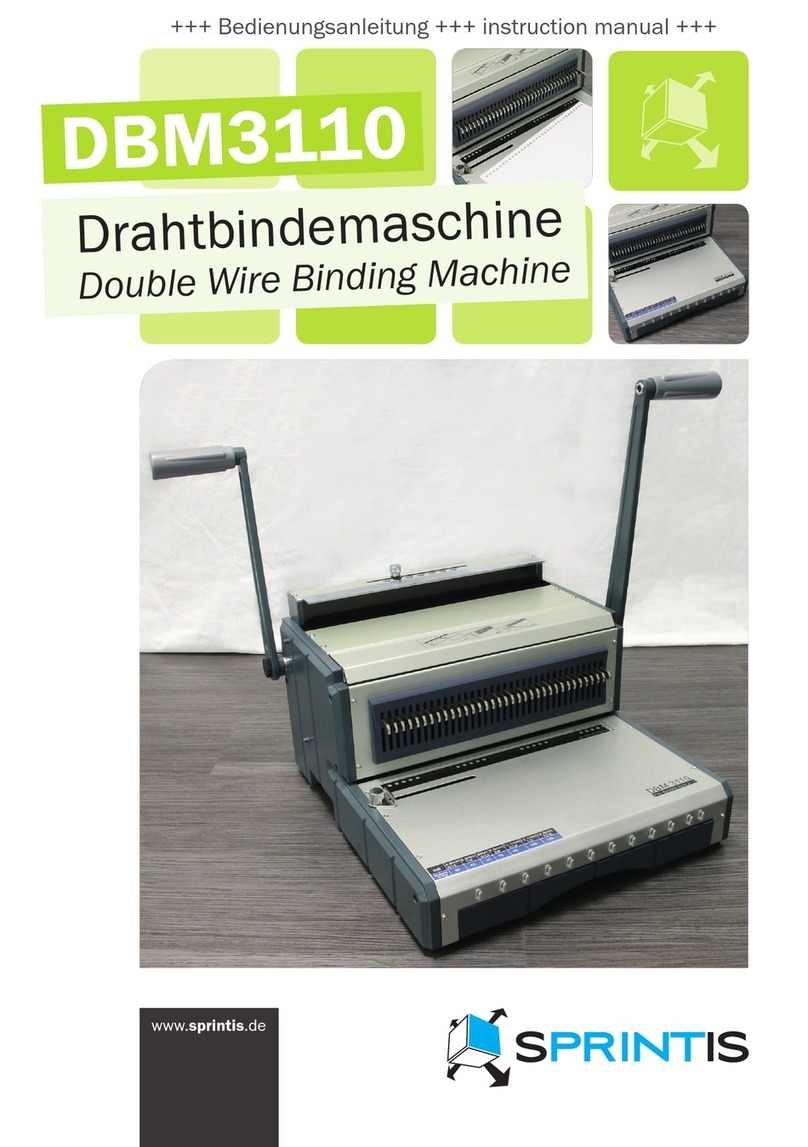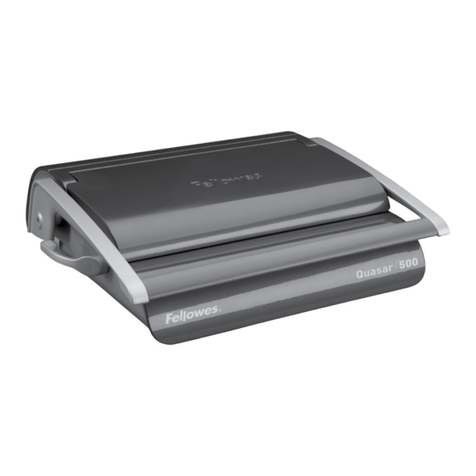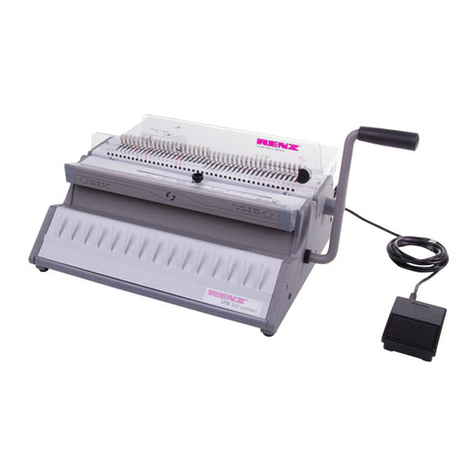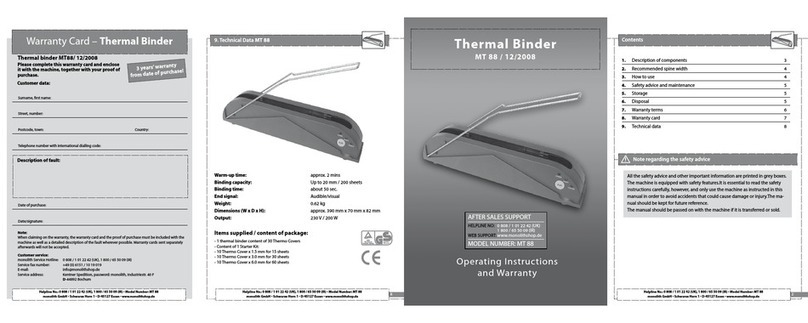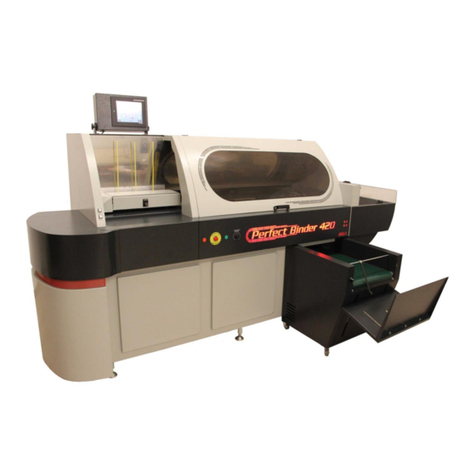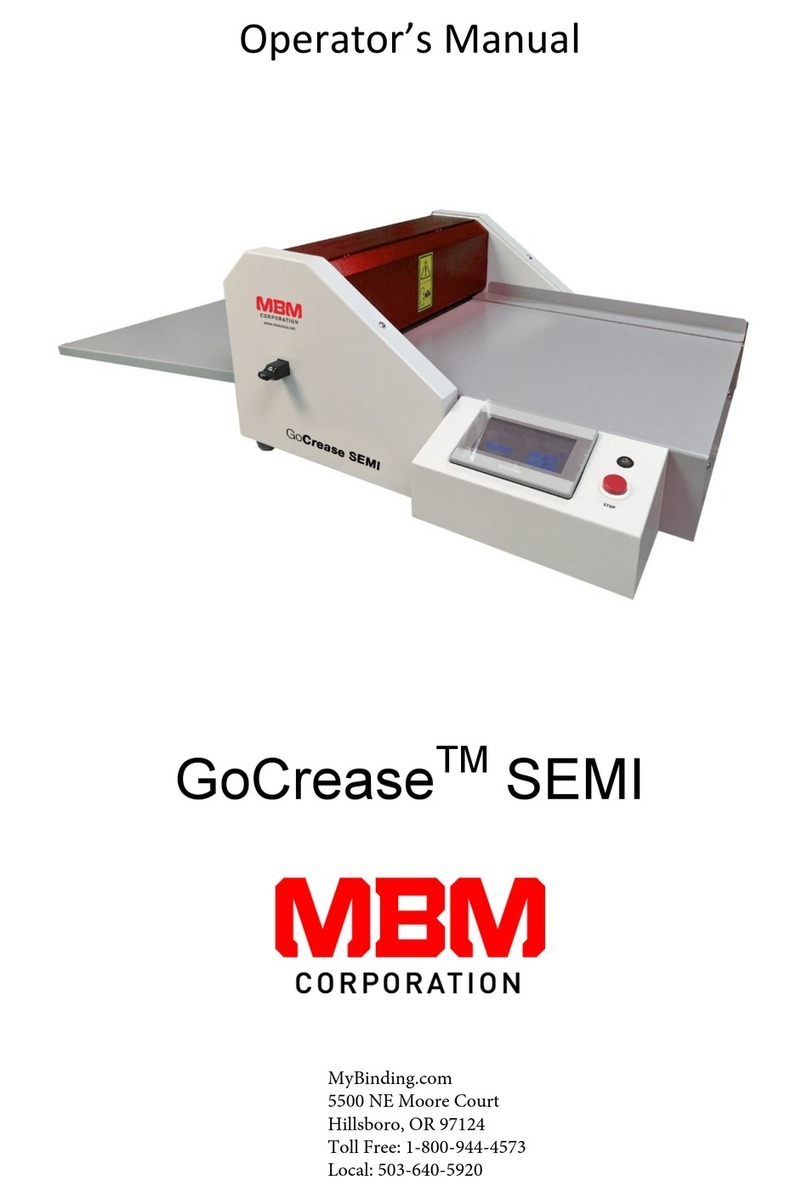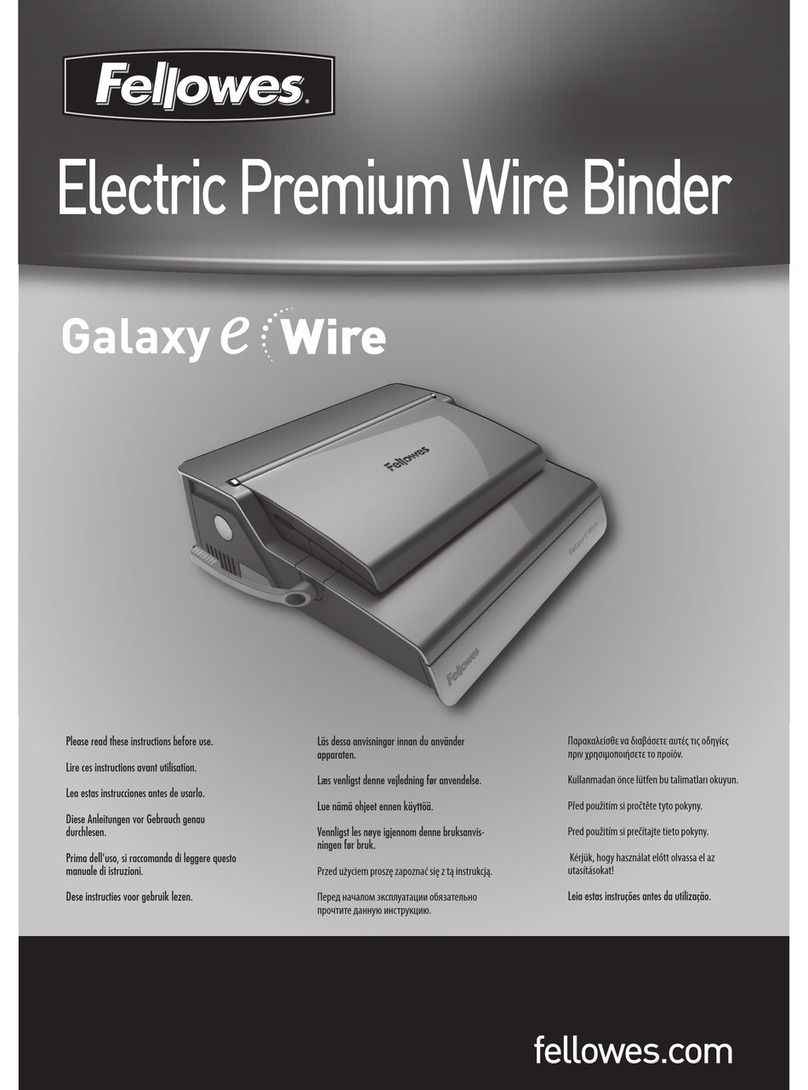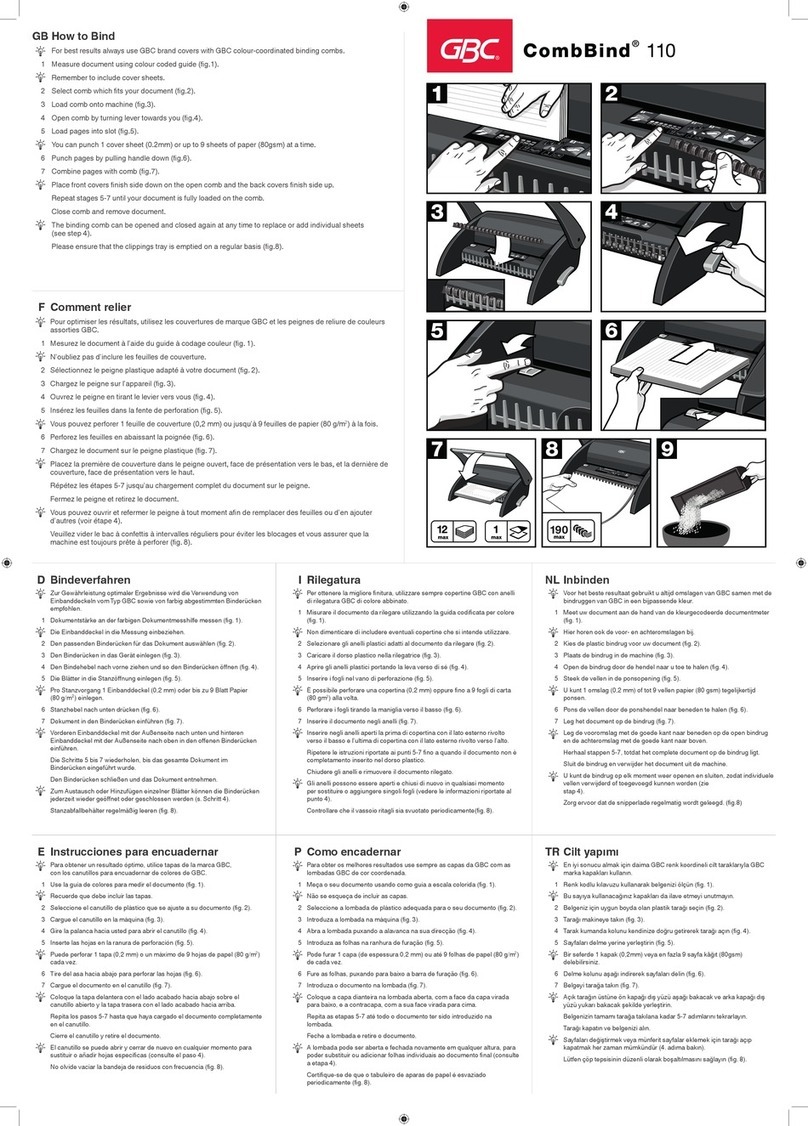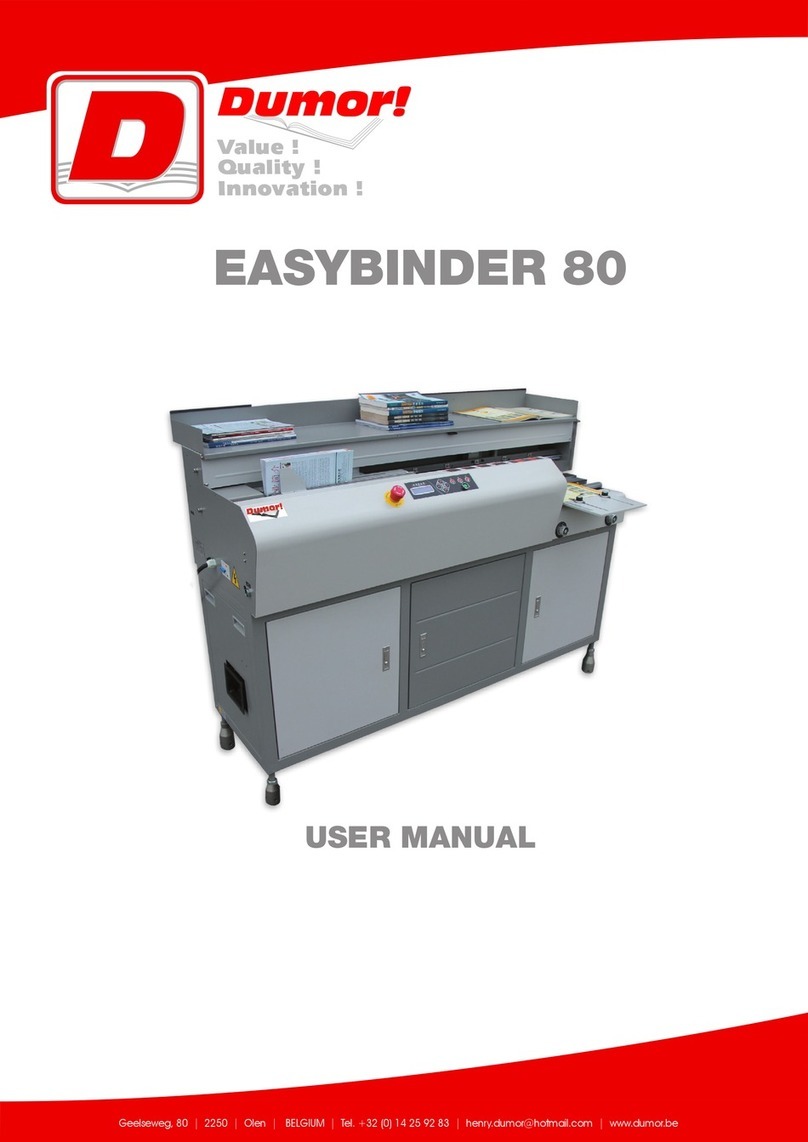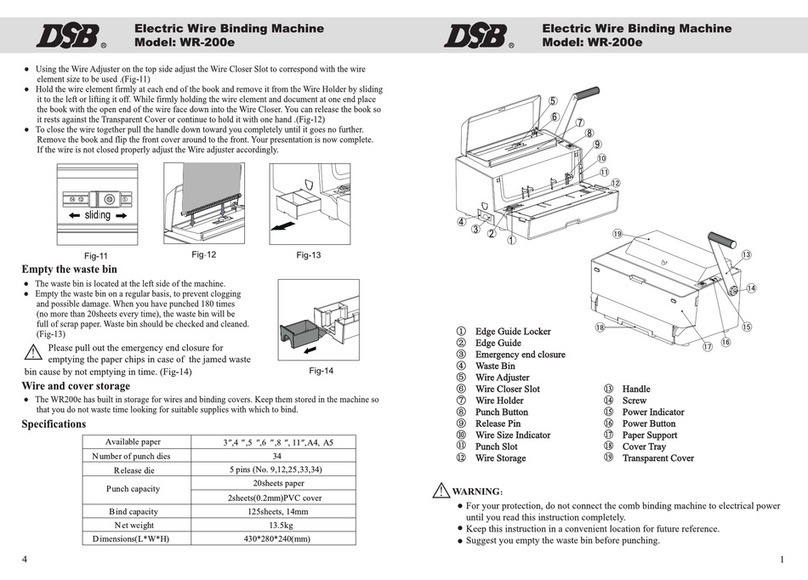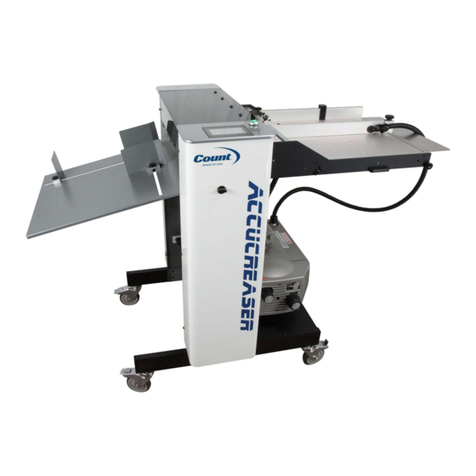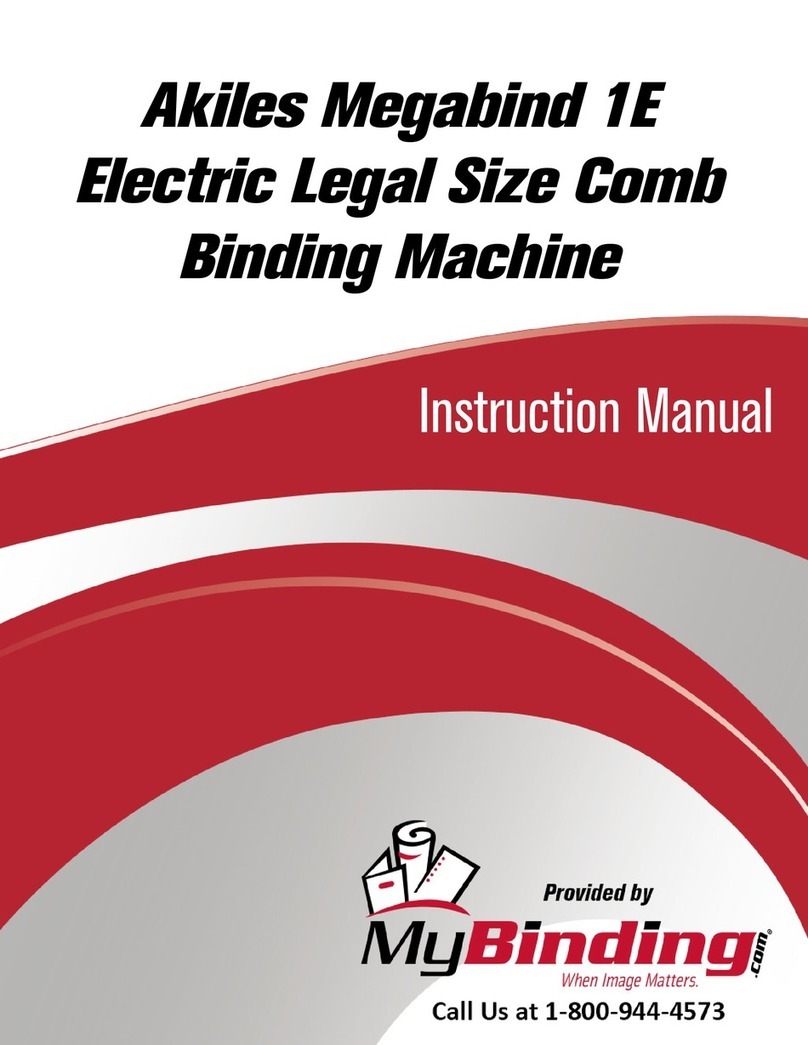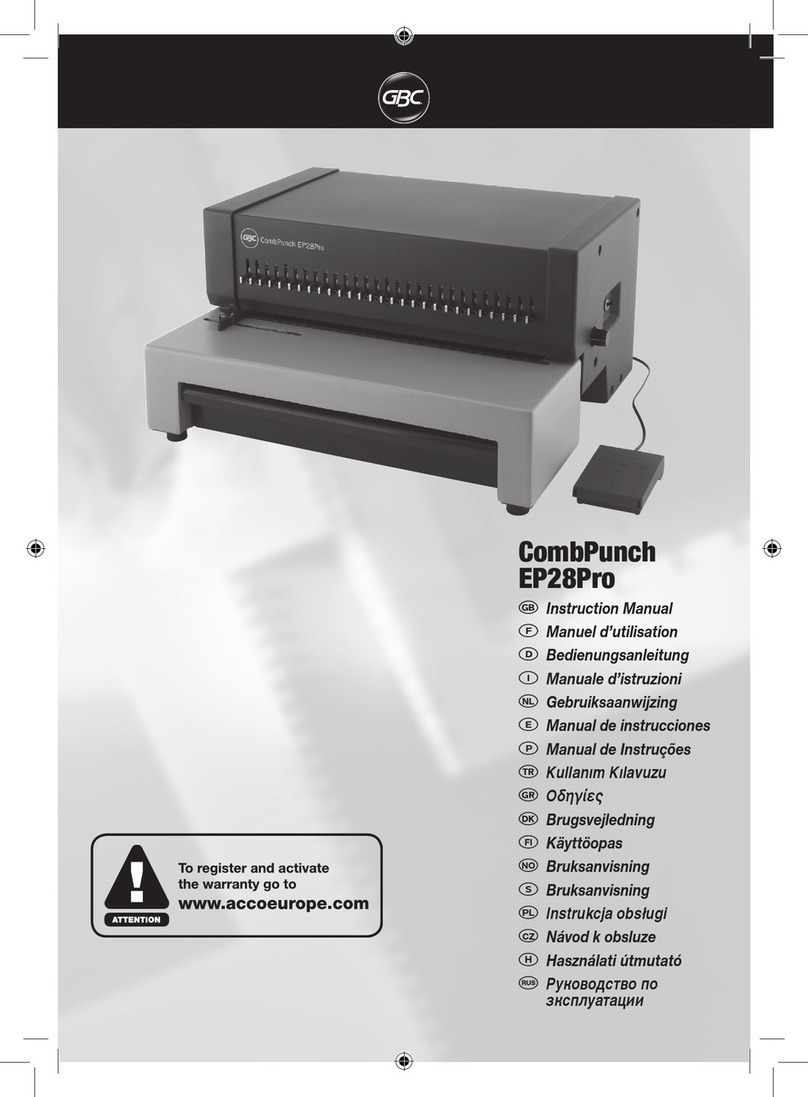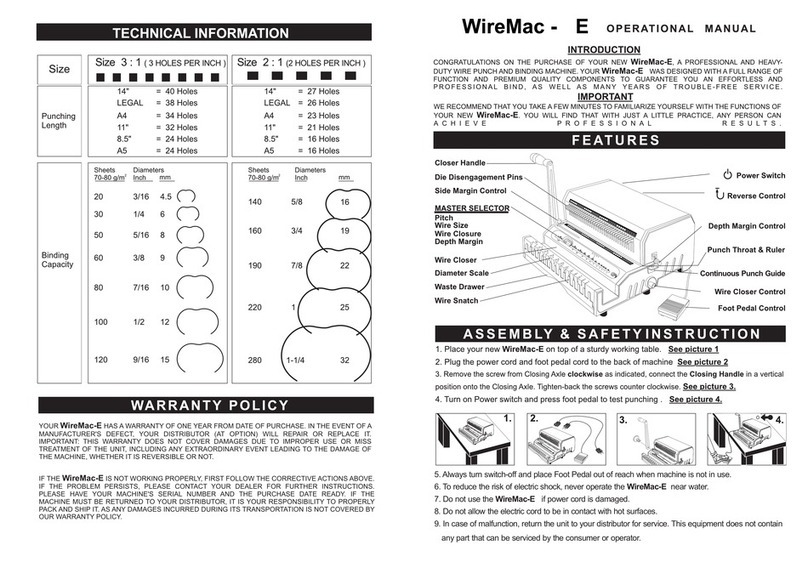General Binding SureBind 230VAC User manual

SERVICE MANUAL
Assembly Numbers 9707101 (SureBind 230VAC), 9707102 (VeloBind 120VAC),
9707103 (SureBind 120VAC), 9707104 (Gestetner SureBind 230VAC), 9707105
(GUSA QB 120VAC), & 9707106 (GUSA 120VAC)
GBC National Service Department
Printed in U.S.A.
Part No. 9781858
Revision A 02/02
©Copyright General Binding Corporation, Northbrook, IL U.S.A.

1.0 INTRODUCTION
This machine is a completely self-contained tabletop unit capable of punching up to 1/8"
(3.2 mm.) thick by 14 7/8" (378 mm.) wide stacks of paper (approximately 25 sheets of
20 pound bond paper). It is capable of binding documents up to 3" (76 mm.) thick by 14
7/8" (378 mm.) wide (approximately 750 sheets of 20 pound bond paper). This machine
is also capable of "debinding" documents up to 3" (76 mm.) thick.
The binding is accomplished by using the VeloBind and SureBind patented strip process.
This process consists of compressing the punched edge of the document between two
plastic strips: one strip with pins, the other strip with matching holes. A heated blade
cuts the pins, and forms a rivet in the countersunk holes of the bottom strip to securely
bind the document pages together.
The "debinding" process is accomplished by inserting the bound document against the
bind edge guide and the strip edge against the backstop, with the small hole in the bottom
strip securely placed on the locating pin. The "debind" switch is depressed turning on the
"debind" indicator light. The pressure bar is lowered onto the document, the blade comes
forward, stops, the "debinding" light illuminates, the display panel counts down the
debind time, and the blade heats the sealed rivets for fifteen seconds. The "debinding"
light extinguishes, the blade retracts, the pressure bar raises, the operator removes the
document, and peels the top strip away from the document.
1-1 9781858-02/02

2.0 SPECIFICATIONS
MODEL/DESCRIPTION: PUNCH/BINDER/DEBINDER (120 VOLT)
PUNCH/BINDER/DEBINDER (240 VOLT)
PUNCH CAPACITY:*1/8" (3.2 mm.) THICK X 14 7/8" (378 mm.)
MAXIMUM WIDTH PER CYCLE -25
SHEETS OF 20 POUND BOND PAPER
*NOTE: No more than 4 composition covers, or 2 plastic covers should be punched at
one time. Punching larger stacks of these materials may result in damage to the
punch mechanism.
BIND CAPACITY: 3" (76 mm.) THICK X 14 7/8" (378 mm.) WIDE
MAXIMUM PER CYCLE -750 PAGES OF 20
POUND BOND PAPER
CYCLE SPEED: 2 SECOND PUNCH CYCLE
8 AND 16 SECOND BIND CYCLES
25 SECOND DEBIND CYCLE
ELECTRICAL REQUIREMENTS: 120 VAC AT 60 HZ -8.5 AMPS
240 VAC AT 50 HZ -4 AMPS
10 AMP FUSE (120 V)
5 AMP FUSE (240 V)
3-WIRE GROUNDED OUTLET
2700-2800 B.T.U.'S PER HOUR
DIMENSIONS: WIDTH: 22.5" (56.4 cm.)
DEPTH: 18.0" (45.7 cm.)
HEIGHT: 13.5" (34.3 cm.)
WEIGHT: 60 POUNDS (27.3 KG.)
2-1 9781858-02/02

3.0 INSTALLATION
1. Remove shipping tape from carton.
2. Remove the two foam supports from left and right corners of the machine.
3. Remove the machine from carton, and remove plastic bag.
4. Remove power cord from package, and plug power cord in rear bottom of the machine.
5. After making sure power source voltage is correct, plug power cord into wall outlet.
6. Plug foot pedal into rear of machine.
7. The machine is now ready to operate. PLEASE READ THE OWNER'S GUIDE BEFORE
ATTEMPTING TO OPERATE THE MACHINE.
PACKAGING MATERIALS
NEW PART
NUMBER DESCRIPTION QUANTITY
9778053 Shipping Carton 1
9776270 Plastic Bag 1
9749321 Dust Cover 1
9776949 Pressure Bar Instructions 1
9777056 Bottom Foam/Cardboard Support 1
9777057 Left Top Foam Support 1
9777058 Right Top Foam Support 1
9781344 Power Cord (115 VAC) 1
9781345 Power Cord (230 VAC) 1
9776367 Owner's Manual 1
3-1 9781858-02/02

4.0 OPERATING INSTRUCTIONS
4.1 OPERATIONAL COMPONENTS LAYOUT
Figure 4-1
A -Foot Pedal
B -Bind Edge Guide
C -Punch Edge guide
D -Debris Tray
E -Punch Surface
F -Strip Recess
G -Bind Surface
H -Backstop
I -Locating Pin
J -Pressure Bar
4-1 9781858-02/02

4.0 OPERATING INSTRUCTIONS
.
DETAIL "A"
K -Power Indicator LED
L -Start/Stop (Power On/Off) Switch
M -Ready Indicator LED
N -<1" (Under 1") Indicator LED
O -<1" (Under 1") Selector Switch
P -Auto Punch Indicator LED
Q -Auto Punch Selector Switch
R -LED Display Window
S -Manual Punch Button
T -Debind Selector Switch
U -Debind Indicator LED
V ->1" (Over 1") Selector Switch
W ->1" (Over 1") Indicator LED
X -Standby Indicator LED
4-2 9781858-02/02

4.0 OPERATING INSTRUCTIONS
4.2 OPERATIONAL COMPONENTS DESCRIPTION
A. FOOT PEDAL:Used for hands free punch operation when the machine is
placed in the "Auto Punch" mode.
B. BIND EDGE GUIDE:Adjustable guide used to align documents for the
binding and debinding cycle.
C. PUNCH EDGE GUIDE:Adjustable guide used to position document to be
punched. In "auto" punch mode, inserting document next to this guide
activates punch cycle immediately.
D. DEBRIS TRAY: Located in base of machine, collects excess paper and
strip debris, and contains operating instructions. Empty frequently.
E. PUNCH SURFACE: Surface where document is placed for punching
holes.
F. STRIP RECESS:The strip recess supports the bottom strip.
G. BIND SURFACE:Surface where document is placed for binding after it is
punched.
H. BACKSTOP: Serves to position document correctly, along with the
locating pin and bind edge guide, so holes are aligned for easy insertion of
top (pin) strip. The scale on the backstop measures document thickness for
selection of pin strip length, or appropriate hard cover size.
I. LOCATING PIN:Centers the strip pins for binding and debinding. The
small hole in the bottom strip must be placed on this pin for proper machine
operation.
J. PRESSURE BAR:Exerts pressure on and holds document in place during
the binding and debinding cycle.
K. POWER INDICATOR LED:Illuminates when "Start" button is depressed
indicating power is being applied to machine.
L. START/STOP (POWER ON/OFF) SWITCH: Pressing the "Start" side
turns machine on. Pressing the "Stop" side turns the machine off.
M. READY INDICATOR LED:Illuminates after approximately 45 seconds.
Indicates machine is ready to bind.
N. < 1" (UNDER 1") INDICATOR LED:Lights when <1" Selector Switch is
depressed.
O. <1" (UNDER 1") SELECTOR SWITCH: Pressing this button places the
machine in fast bind mode. Bind cycle is cut in half from standard bind
mode. Used for books less than 1 inch in thickness.
P. AUTO PUNCH INDICATOR LED:Lights when Auto Punch Selector
Switch is depressed. 4-3 9781858-02/02

4.0 OPERATING INSTRUCTIONS
4.2 OPERATIONAL COMPONENTS DESCRIPTION (CONT’D.)
Q. AUTO PUNCH SELECTOR SWITCH: Pressing this button allows the
operator to actuate the punch cycle automatically by placing the paper stack
next to the punch edge guide, or by depressing the foot pedal.
R. LED DISPLAY WINDOW: Displays a chasing line while machine warms
up, displays the current number of binds up to 99, and counts down the
Debind cycle. Allows technician to set debind time, temperature, and to
check the counter.
S. MANUAL PUNCH BUTTON:When Auto Punch is not depressed, this
button must be depressed in order to punch the paper stack.
T. DEBIND BUTTON: Pressing this button places machine in debind mode
for debinding documents.
U. DEBIND INDICATOR LED: Lights when Debind Selector Switch is
depressed.
V. >1" (OVER 1") SELECTOR SWITCH: Pressing this button places the
machine in standard bind mode. The standard bind mode is recommended
for documents over 1 inch where maximum binding strength is required.
W. >1" (OVER 1") INDICATOR LED: Lights when >1" Selector Switch is
depressed.
X. STANDBY INDICATOR LIGHT: Illuminates after On Button pressed -
indicates machine is in warm-up mode. Goes out when machine is ready.
4-4 9781858-02/02

4.0 OPERATING INSTRUCTIONS
4.3 PUNCHING
1. Push On Button "R" to turn machine on.
2. Loosen Punch Edge Guide Knob, and position Punch Edge Guide "A" so line on decal
matches paper size line on Punch Platen "H". Proper positioning of the Punch Edge Guide
"A" allows correct punching of your document to ensure it does not extend beyond the
strip on either end when bound.
3. Select the desired punch mode.
A. To select "Automatic Punch Mode", press Auto Punch Button "N". Insert your
document into the Punch Throat squarely just to the right of the Punch Edge Guide "A"
and slide your document left to the Punch Edge Guide "A" to activate the punch cycle
(the metal piece you see inside the guide is the punch cycle "trigger" or "actuator").
B. To punch manually, insert your document into the Punch Throat squarely next to the
Punch Edge Guide "A", and press the Manual Punch Button "O".
C. To punch using the Foot Pedal, insert your document into the Punch Throat squarely
next to the Punch Edge Guide "A", and depress the Foot Pedal.
4. Punch a test sheet of paper. Fold punched test sheet to check punch hole location and
alignment from edges of paper to ensure holes are equally spaced from edges of sheet (see
Figure 4-2). Adjust Punch Edge Guide "A" if necessary, and recheck test sheet punched
after adjustment.
5. After ensuring your Punch Edge Guide "A" is properly positioned, tighten the Punch Edge
Guide Knob, jog document to be punched so all edges are even, and insert document into
Punch Throat according to step 3-A or 3-B instructions depending on punch mode selected.
Figure 4-2
4-5
9781858-02/02

4.0 OPERATING INSTRUCTIONS
4.4 DOCUMENT ASSEMBLY
1. Insert the bottom strip (strip with holes) into the Strip Recess "F", textured side down, fitting
the small hole in strip over the Locating Pin "D" which protrudes slightly from the bottom
surface of the Strip Recess "F". Note: The position of the Locating Pin is indicated by the
arrow painted on the Backstop "E". When the strip is correctly positioned, the hole closest to
the left end of the strip will be aligned with the vertical line on the Backstop "E".
Note: Failure to properly place the small hole in the bottom strip over the
Locating Pin will result in the pins not being cut off, and can jam up the
machine.
2. Place the punched document face up (first sheet on top and last sheet on bottom) on the Bind
Platen "G", with the left edge of the document next to the Bind Edge Guide "B", and the
punched edge resting against the Backstop "E". Note: The Bind Edge Guide "B" is properly
adjusted when the punched holes of the document are aligned with strip holes and the left
edge of the document is resting next to the Bind Edge Guide "B".
3. The maximum binding capacity of the machine is 3 inches. If document is to be enclosed in a
soft cover, the front and back covers must be assembled as shown in Figure 4-3, and bound
into the document at this time. If document is to be enclosed in a hard cover, VeloBind
endsheets must be bound into the document at this time. The endsheets are placed on the
front and back of the document with the printed release paper facing out, and the plain white
sides facing the first and last sheets of the document. (The hard cover will be attached to the
document after the binding is completed.)
4. Insert the top strip (strip with pins) into the holes in the document and bottom strip. Press the
top strip down firmly until it contacts the top sheet of the document.
4-6
9781858-02/02

4.0 OPERATING INSTRUCTIONS
4.5 BINDING
1. Press >1" Button "K" or <1" Button "L" to place machine in desired binding mode.
2. Lower the Pressure Bar "C" onto top binding strip and document stack.
3. The binding cycle will begin immediately and automatically. When the binding process is
completed (approximately 16 seconds in >1" mode, and 8 seconds in <1" mode), the Pressure
Bar "C" will raise automatically, and the bound document can be removed.
4. The Debris Tray "J" should be checked and emptied frequently if the machine is used
consistently. If periodically used, Debris Tray "J" should be checked and emptied on a daily
basis. Make sure the Debris Tray "J" is reinserted properly and completely into the Base.
Excess pin buildup and damage may occur if the tray is not inserted fully into the base.
Figure 4-4
4-7
9781858-02/02

4.0 OPERATING INSTRUCTIONS
4.6 DEBINDING
1. Place document to be debound as follows:
A. Bound edge against Backstop "E".
B. Small hole in bottom strip over Locating Pin "D".
C. Edge of document next to Bind Edge Guide "B".
2. Once the document to be debound is properly located, press the Debind Button "M" to place
in debind mode.
3. Lower the Pressure Bar "C" onto document, and the machine will go through the debinding
cycle.
4. Immediately after the Pressure Bar "C" raises (approximately 25 seconds), remove the
document and peel the top strip off.
5. Press either Standard Bind Button "K", or Fast Bind Button "L" to place the machine back in
binding mode.
4-8
9781858-02/02

5.0 TROUBLESHOOTING
5.1 MAIN P.C. BOARD SCHEMATIC
Figure 5-1
5-1 9781858-02/02

5.0 TROUBLESHOOTING
5.2 KEY PAD SCHEMATIC
Figure 5-2
5-2 9781858-02/02

5.0 TROUBLESHOOTING
5.3 SCHEMATIC
Figure 5-3
5-3 9781858-02/02

5.0 TROUBLESHOOTING
5.4 WIRING DIAGRAM
Figure 5-4
5-4 9781858-02/02

5.0 TROUBLESHOOTING
5.5 MECHANICAL OPERATION
5.5.1 PUNCH ASSEMBLY OPERATION -Figure 5-5
The Punch Motor Assembly (1) consists of the Punch Motor, Gear Box, and Punch Shaft.
Cranks (2) are attached to each end of the Punch Motor Shaft (3). During the punch
cycle, the Cranks (2) rotate, pulling the attached Punch Links (4) and Punch Actuator (1,
Figure 5-3) through the paper stack.
The Punch Motor Assembly (1) has an internal thermal cutoff which will shut the motor
off if it gets too hot due to excessive punching. If this occurs, discontinue punching for
approximately 20 minutes to allow the motor time to cool down.
Figure 5-5
5-5
9781858-02/02

5.0 TROUBLESHOOTING
5.5 MECHANICAL OPERATION
5.5.2 PUNCH ASSEMBLY OPERATION -Figure 5-6
The Punch Assembly consists of the Punch Actuator (1), Punch Pins (2), Punch Housing
(3), and Punch Spacer (4) held together by 3 Retaining Pins (5) with Plastic Washers (6)
inserted through the assembled operational components, and secured with 3 Retaining
Clips (7). Punching is performed when the Punch Links (8) attached to each end of the
Punch Actuator (1) are pulled down by Punch Motor Cranks (2, Figure 5-5). The Punch
Actuator (1) drives the 14 Punch Pins (2) through the paper stack and through die holes
in the Punch Housing (3). The Punch Pins (2) enter the paper in staggered intervals to
provide a more even load on the Punch Motor Assembly (1, Figure 5-5).
Figure 5-6
5-6
9781858-02/02

5.0 TROUBLESHOOTING
5.5 MECHANICAL OPERATION
5.5.3 PUNCH TIMING OPERATION -Figure 5-7
The Punch Timing is controlled by the Punch Timing Switch (S-8)(1), and the Punch
Cam (2). The size of the Punch Cam (2) is such that the Lobe (3) rotates once for each
punch cycle. The Punch Timing Switch (1) is mounted to the left hand side plate and is
operated by its Actuator (4).
When the punch cycle is activated by closing the Manual Punch Switch (S-7), or Auto
Punch Switch (S-4), the Punch Shaft (3, Figure 5-5) rotates the Punch Cam (2). The
Lobe (3) on the Cam (2) will move away from the Switch Actuator (4), closing Punch
Timing Switch (1). This provides a secondary circuit holding on the Punch Motor (1,
Figure 5-5). The Punch Motor (1, Figure 5-5) will cycle until the Lobe (3) on the Punch
Cam (2) rotates around and contacts the Punch Timing Switch Actuator (4). When this
occurs, the Punch Motor (1, Figure 5-5) stops immediately.
Figure 5-7
5-7
9781858-02/02

5.0 TROUBLESHOOTING
5.5 MECHANICAL OPERATION
5.5.4 PUNCH BRAKE ASSEMBLY OPERATION -Figure 5-8
The Punch Brake Assembly consists of a Brake Hub (1) attached to the end of the Punch
Motor Shaft (3, Figure 5-5), and the Lever Arm (2) attached to a Solenoid (3). The
Solenoid (3) is wired in parallel with the Punch Motor (1, Figure 5-3), and energizes
when the punch cycle starts. The Lever Arm (2) retracts, allowing the Brake Hub (1) and
Punch Motor (1, Figure 5-5) to rotate. When the Punch Motor (1, Figure 5-5) and
Solenoid (3) de-energize, the Lever Arm (2) engages the Brake Hub (1), stopping
(braking) the Punch Motor Shaft (3, Figure 5-5) rotation.
The Punch Motor Brake Assembly is used to ensure the Punch Pins (2, Figure 5-6) are
stopped in the home position after each punch cycle.
Figure 5-8
5-8
9781858-02/02
This manual suits for next models
5
Table of contents
Other General Binding Binding Machine manuals
